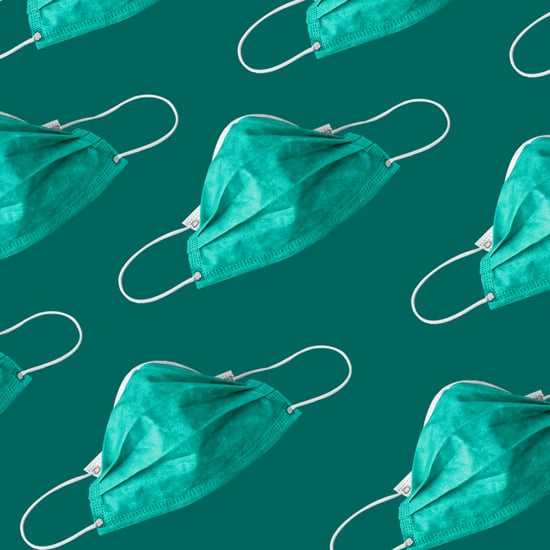Is Coronavirus Airborne?
Experts Are Saying There Is Mounting Evidence That Coronavirus Is Airborne

Whether or not the novel coronavirus (COVID-19) is airborne has been debated in recent months and has garnered more attention in the past week after 239 experts signed an open letter arguing that the World Health Organization (WHO) and other public health agencies have not properly recognised the possibility that humans can spread the virus through small droplets called aerosols. Up until recently, WHO maintained that airborne transmission was of risk only when aerosols are dispersed from infected patients during procedures in healthcare settings such as tracheal intubation and bronchoscopy. In a July 9 scientific briefing that breaks down the modes of transmission of COVID-19, WHO acknowledged that airborne transmission is possible in other cases, though more research still needs to be done.
What Exactly Are Aerosols?
For background, there's a difference between respiratory droplets that can travel briefly and sink to the ground — which the CDC and WHO acknowledge is the main form of transmission — and tiny droplets called aerosols. Aerosols are smaller than five micrometers or microns and can "float around for a while," Emily Landon, MD, medical director of antimicrobial stewardship and infection control at University of Chicago Medicine, explained in an article for UChicago.
Dr. Landon wrote the article back in March only days after a national emergency was first declared in the US due to the COVID-19 pandemic. But she explained the general distinction between aerosols and the "small bits of fluid that you can feel and see when someone sneezes," which is what the CDC and WHO typically refer to when they talk about droplet transmission. Aerosols are like hairspray in a room, she said. When you go into the bathroom later, it lingers. Furthermore, aerosols are airborne, and the larger droplets you can see when you cough or sneeze are essentially not.
The Debate Around Airborne Transmission Explained
The experts who signed the open letter argue that studies do suggest COVID-19 can in fact be airborne and travel through aerosols from person to person when someone breathes, talks, sings, etc., and it's especially risky when people are indoors with poor ventilation. The section on airborne transmission in WHO's scientific briefing essentially says WHO has been actively evaluating transmission through aerosols particularly in those poorly ventilated indoor settings, and the organisation maintains its viewpoint on the main risk of airborne transmission being from medical procedures that generate aerosols. Anne Liu, MD, immunologist and infectious-disease doctor with Stanford Health Care, previously explained to POPSUGAR that these procedures could be, for instance, putting a tube down patients' throats to help them breathe. Procedures such as this could potentially make patients cough or gag, she said, and could generate more aerosols.
However, WHO also now acknowledges the possibility of aerosol transmission through normal breathing and talking as well as when respiratory droplets evaporate. The scientific briefing states that people could therefore inhale aerosols and could become infected "if the aerosols contain the virus in sufficient quantity." More research on how much of these viral aerosols need to be ingested to cause infection is required, WHO says, something Benedetta Allegranzi, WHO's technical lead on infection control, acknowledged in a July 7 press briefing, too.
A study from The New England Journal of Medicine meant to mimic sneezes or coughs from humans suggested aerosols remained viable in the air for three hours, and researchers told The New York Times in response that aerosols could likely be suspended in the air for 10 minutes to half an hour, as the aerosols wouldn't last a full three hours airborne in a setting outside of the lab. WHO reiterated this fact in its July 9 scientific briefing, stating that these "findings were from experimentally induced aerosols that do not reflect normal human cough conditions."
Airborne Transmission in "Superspreading Events"
The open letter from experts specifically states that airborne transmission is the "only plausible explanation" for what is now being called "superspreading events", where clusters of people are infected with COVID-19. For instance, a single individual with COVID-19 infected a confirmed 32 people (and 20 more probable others) during a two-and-a-half-hour choir practice in Washington State, in the US.
An early release paper published by the CDC, which looked at clusters of COVID-19 in Japan from January to April, noted many clusters were associated with "heavy breathing in close proximity, such as singing at karaoke parties, cheering at clubs, having conversations in bars, and exercising in gymnasiums". The size of the droplets in these scenarios is not clear, but those who signed the open letter believe airborne transmission is likely the case in superspreading events in general.
A transmission FAQ page also published on the WHO website on July 9 acknowledges that there have been reported outbreaks of COVID-19 "in some closed settings, such as restaurants, nightclubs, places of worship or places of work where people may be shouting, talking, or singing. In these outbreaks, aerosol transmission, particularly in these indoor locations where there are crowded and inadequately ventilated spaces where infected persons spend long periods of time with others, cannot be ruled out". However, WHO's scientific briefing makes clear that larger droplet and fomite transmission (contaminated surfaces) could also explain these clusters of cases, especially if masks were not worn, hand hygiene was not followed, and physical distancing was not maintained. More studies, WHO says, "urgently" need to investigate this.
Linsey Marr, an aerosol expert at Virginia Tech, who was one of the people working on that open letter, told The New York Times it's unclear how often the virus is spread via aerosols compared with larger droplets that are expelled. Aerosols contain less of the virus than larger droplets do, but they can linger longer in the air. And, via The New York Times, experts have said for months that "infected people also are releasing aerosols when they cough and sneeze. More important, they expel aerosols even when they breathe, talk, or sing, especially with some exertion". The fact that WHO is now acknowledging the possibility illustrates that what we know about COVID-19 is constantly evolving.
Key Prevention Measures to Take From Here
There are factors that help protect us from the spread of virus-containing respiratory droplets, though. For instance, airflow plays a part. The risk is highest in crowded indoor spaces with poor ventilation like some churches, restaurants, clubs, and gyms. As Dr. Liu told POPSUGAR, "I hope that people understand that the longer you are indoors with other people, even if they're wearing cloth masks or surgical mask, the higher the risk of transmission becomes." Air circulation, she said, disperses respiratory droplets more effectively.
Let's be clear: this doesn't mean COVID-19 particles are just travelling through the air wherever you go. Bill Hanage, an epidemiologist at the Harvard T.H. Chan School of Public Health, clarified to The New York Times, "We have this notion that airborne transmission means droplets hanging in the air capable of infecting you many hours later, drifting down streets, through letter boxes and finding their way into homes everywhere." That, he said, is not the case. Instead, we should be wary of being in close range of people, especially indoors and especially when there is a lack of physical distancing happening in a crowded place.
The experts in the open letter stated that there is enough supporting evidence of airborne transmission to take precautions. WHO recommends avoiding closed settings and crowded situations, and it recommends "appropriate and optimal" ventilation of indoor environments, as was explained in the press briefing. What's more, WHO recommends physical distancing and masks. For the general public, fabric masks are suggested in areas of widespread transmission where physical distancing is not possible. Medical masks (including N95 face masks and surgical face masks), WHO says, should be saved for healthcare workers, anyone with symptoms suggestive of COVID-19, people caring for those with COVID-19, and high-risk individuals when they cannot physically distance.
What to Remember Moving Forward
Wear masks when physical distancing cannot occur, especially when indoors. N95 masks filter out most aerosols, but cloth masks are recommended for the general public. "Even cloth masks, if worn by everyone, can significantly reduce transmission," one aerosol expert told The New York Times.
Avoid crowded places, especially indoors where you can't physically distance from others. Superspreading events can occur when people are indoors for long periods of time with poor ventilation.
Focus on ventilation. The experts' open letter states that providing "sufficient and effective ventilation (supply clean outdoor air, minimise recirculating air)" is important particularly in public buildings, workplace environments, schools, hospitals, and healthcare facilities for older adults. Opening both doors and windows, they said, can "dramatically increase air flow rates in many buildings."
Don't forget about other safety measures. Wash your hands and stay home if you feel sick. If you are a person who is at a higher risk of infection, take appropriate precautions. Call your doctor with any questions, and follow the guidelines put in place where you live.








